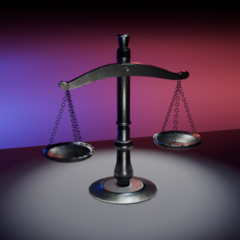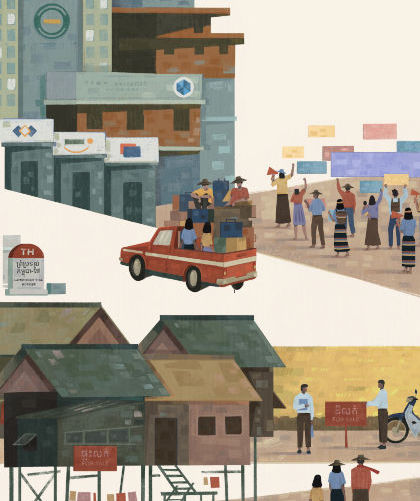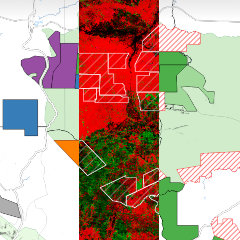Conclusion of Two Cases Related to Chut Wutty Slaying Leave More Questions Than Answers
Published on 22 October 2012Timber Green employee Ran Boroath was sentenced to two years in prison today for allegedly killing the military police officer that the government claims killed environmental activist Chut Wutty.
Three-quarters of the sentence was suspended, however, and Ran Boroath is due to be released from prison within the next two weeks.
Chut Wutty was shot dead in a remote, isolated corner of the Cardamom Mountains on April 26 while investigating illegal logging with two Cambodia Daily journalists. Military police officer In Rattana was also killed by gunfire. Government officials put forward an array of bizarre and contradictory explanations for Wutty’s death, before finally pinning the shooting on In Ratanna.
During a 90-minute proceeding before the Koh Kong Provincial Court on October 4, 2012, Boroath testified that he tried to disarm Ratanna after Wutty was shot, but accidentally killed Ratanna with his own AK-47. Boroath was convicted of “unintentional homicide,” which carries a maximum sentence of three years.
Just prior to Boroath’s trial, Judge Judge Khan Sophary announced that the court had officially dropped its investigation of Wutty’s death. According to the court, it had split the legal case related to the April 26 shootings into two – one to investigate Wutty’s death and one to investigate Ratanna’s death. Because the investigation into Wutty’s killing had concluded that Ratanna was responsible, the court stated that no further proceedings on that case were warranted.
“The investigation into Chut Wutty’s killing has been a mockery of justice from day one – from the farcical explanations for his death, to the presentation of vague, uncontested conclusions masquerading as a trial,” said LICADHO Director Naly Pilorge. “A shooting leaves the most prominent environmental activist in Cambodia dead, as well as a military police officer, and the result of the investigation is that the one private security personnel who was not armed during the incident gets six months in prison. This is a very chilling precedent for anyone who wants to speak out against the status quo in Cambodia.”
Boroath’s trial contained an array of irregularities, rendering the court less of a truth seeking tribunal and more of a public-relations organ.
The proceeding against Boroath should have, as a threshold matter, included the presentation of evidence substantiating the claim that Ratanna shot Wutty. Without such evidence, it is not possible to legally establish that Boroath acted in self-defense by trying to disarm Ratanna. Yet no credible evidence of Ratanna’s guilt was revealed during Boroath’s cursory 90-minute trial. Indeed, no hard evidence was presented whatsoever. The court did not hear about any bullet analysis, fingerprints, powder burn analysis, wound trajectories, or the locations or quantity of found bullet casings. There was no attempt at even presenting a basic diagram showing where the individuals involved stood during the incident and explaining the resulting bullet holes in Wutty’s vehicle or wounds on Ratanna’s body.
On the contrary, Boroath’s failed attempt to re-enact Ratanna’s shooting in the courtroom clearly demonstrated the story’s implausibility: There is simply no way Ratanna’s long gun could have turned 180 degrees, resulting in two separate wounds spaced several inches apart on Ratanna’s chest and stomach.
Several key witnesses were not present at the trial – including one soldier moonlighting as Timber Green security staff who, according to several accounts, was a key actor in the events leading up to the shootings, and was masked and apparently intoxicated. There was no attempt to justify these absences.
As a result, most of the trial consisted of the court clerk reading short witness statements aloud. The eight written statements were most striking in their ambiguities, inconsistencies, and failures to address crucial details. Several simply recounted conversations with other purported witnesses, adding another level of hearsay to an already unreliable presentation. Without the witnesses present, there was no way for the judge, prosecution, or defense attorney to question the inconsistencies or to press for additional details.
Of the individuals who testified in court, only one claimed to have been witness to the shooting himself, Timber Green employee and military police So Sopheap. Sopheap, the sole eye-witness in court other than Boroath himself, testified briefly and succinctly, stating that he did not think Ratanna had intended to kill Wutty, and that Boroath had probably saved the journalists’ lives.
None of the other individuals called to testify in court had seen the shooting. One, a Timber Green company supervisor, acknowledged that his security staff had called to inform him of Wutty’s presence and the fact that he was taking photographs with two journalists in tow. The supervisor claimed he took no action in response to this phone call.
A military official also testified briefly about an interview he conducted with a witness to the shooting. That absent witness supposedly told the officer that Ratanna had killed Wutty before Boroath accidentally killed Ratanna. Again, there was no justification offered for the witness’ failure to appear in court himself. When questioned about bullet casings, the officer said he found maybe two or three. There was no follow-up to this vague response.
Testimony throughout the trial also brushed aside the events leading to the shooting, namely the confiscation of camera equipment and roadblock, by simply stating that Wutty had no permit to take photographs in the forest.
Before the closing statements, the court asked the Head of the Investigation Committee that was formed to examine Wutty’s death, General Mok Chito, to testify. General Chito had observed the entire proceedings, and echoed the conclusory testimonies, stating simply that he had interviewed 11 witnesses. Without offering any further details, he stated that he had determined that Ratanna shot Wutty before being killed by bullets that accidentally discharged from Ratanna’s own gun as Boroath tried to disarm him. Chito’s testimony did not describe any forensic testing that had taken place.
“The so-called trial was really more of a quick, unconvincing plea bargain proceeding,” said LICADHO Director Naly Pilorge. “Wutty’s death deserves true justice, and this requires proper investigation and disclosure of credible evidence to the public to combat the ongoing perception of impunity surrounding this tragedy.”
For more information, please contact:
▪ Naly Pilorge, LICADHO Director, 012 803 650
PDF: Download full statement in English - Download full statement in Khmer
MP3: Listen to audio version in Khmer







